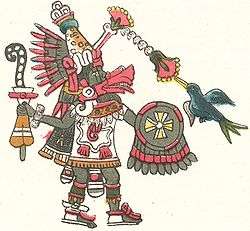Fingerprints of the Gods
.jpg) Cover of the first American edition | |
| Author | Graham Hancock |
|---|---|
| Language | English |
| Subject | Alternative archaeology |
Publication date | 1995 |
| Media type | |
Fingerprints of the Gods: The Evidence of Earth's Lost Civilization is a 1995 book by Graham Hancock, in which he echoes 19th century writer Ignatius Donnelly, author of Atlantis: The Antediluvian World (1882), in contending that some previously enigmatic ancient but highly advanced civilization had existed in prehistory, one which served as the common progenitor civilization to all subsequent known ancient historical ones. The author proposes that sometime around the end of the last Ice Age this civilization ended in cataclysm,[1] but passed on to its inheritors profound knowledge of such things as astronomy, architecture, and mathematics. His theory is based on the idea that mainstream interpretations of archaeological evidence are flawed or incomplete.
Thesis

The book pivots on "fingerprints" of allegedly influenced civilizations, evidence of which Hancock finds in the descriptions of Godmen like Osiris, Thoth, Quetzalcoatl, and Viracocha. These creation myths predate history, and Hancock suggests that in 10,450 BC, a major pole shift took place, before which Antarctica lay farther from the South Pole than today, and after which it shifted to its present location. This earlier civilization theoretically centered on Antarctica, and later survivors built the Olmec, Aztec, Maya and Egyptian civilizations.
Hancock was influenced by Rose and Rand Flem-Ath's When the Sky Fell: in Search of Atlantis (1995/2009), in which they expand the evidence for Charles Hapgood's theory of earth-crust displacement and propose Antarctica as the site of Atlantis.
The pole-shift hypothesis hinges on Charles Hapgood's theory of Earth Crustal Displacement.[2] Hapgood had a fascination with the story of Atlantis and suggested that crustal displacement may have caused its destruction. His theories have few supporters in the geological community compared to the more widely accepted model of plate tectonics.
Reception
Members of the scholarly and scientific community have described the proposals put forward in the book as pseudoscience and pseudoarchaeology.[3][4]
Canadian author Heather Pringle has placed Fingerprints specifically within a pseudo-scientific tradition going back through the writings of H.S. Bellamy and Denis Saurat to the work of Heinrich Himmler's notorious racial research institute, the Ahnenerbe, and the 'crackpot theories' of Nazi archaeologist Edmund Kiss. Pringle draws attention to Fingerprints' 'wild speculations' on the origins of Tiwanaku and describes Hancock as a 'fabulist'.[5]
Fingerprints of the Gods has been translated into 27 languages and is estimated to have sold more than three million copies around the world.[6]
A second edition of the book was published in 2001, entitled Fingerprint of the Gods: The Quest Continues. It includes a new introduction and new appendices in which Hancock responds to some of his critics.
Influence
In 2009, Roland Emmerich, the Hollywood director, released his blockbuster disaster movie 2012 citing Fingerprints of the Gods in the credits as inspiration for the film.[7] In a November 2009 interview with the London magazine Time Out, Emmerich states: "I always wanted to do a biblical flood movie, but I never felt I had the hook. I first read about the Earth's Crust Displacement Theory in Graham Hancock's Fingerprints of the Gods."[8]
In the extras of the Blu-ray 10,000 BC, the director Emmerich and his co-writer Harald Kloser said that they had found inspiration in the same book.[9]
Notes
- ↑ Moss, Stephen (2002-02-06). "Castles in the sea". The Guardian. Retrieved 2009-11-28.
- ↑ Hapgood, Charles Hutchins; Earth's Shifting Crust: A Key to Some Basic Problems of Earth Science (Pantheon Books, 1958; foreword by Albert Einstein)
- ↑ Fagan, Garrett G. Archaeological Fantasies:How Pseudoarchaeology Misrepresents the Past and Misleads the Public Routledge 6 Jan 2006 ISBN 978-0-415-30593-8 p. 28
- ↑ Nunn, Patrick D. Vanished Islands and Hidden Continents of the Pacific University of Hawaii Press (15 Aug 2008)ISBN 978-0824832193 p. 128
- ↑ Pringle, Heather, The Master Plan: Himmler's Scholars and the Holocaust (2006), Fourth Estate, London: p.310
- ↑ "Graham Hancock Biography". GrahamHancock.com. Retrieved 2009-11-26.
- ↑ "2012 (2009) - Credit List" (PDF). chicagoscifi.com. Retrieved 2009-11-25.
- ↑ Jenkins, David (2009-11-16). "Roland Emmerich's guide to disaster movies". Time Out. Retrieved 2009-11-25.
- ↑ (Italian) Tambone, Alessio (15 September 2008). "Versione Stampabile _ Blu-ray 10.000 AC". AV Magazine (in Italian). Retrieved 28 July 2013.
External links
- Brass, M., 2002, Tracing Graham Hancock's Shifting Cataclysm. Skeptical Inquirer. vol. 26, no. 4, pp. ??–??.
- Edlin, D., nd, The Gentle Art of Myth Management. Hall of Ma’at Papers
- Fagan, G., nda, Tiwanaku: Alternative History in Action, Hall of Ma’at Papers
- Fagan, G., ndb, An Answer to Graham Hancock, Hall of Ma’at Papers
- Hancock, Graham, nd, Fingerprints of the Gods Hancock's own page on the book
- Heinrich, P.; Geoarchaeology pages; Hall of Ma’at Papers; scroll down to Hancock's Scholarship section Comments on geology discussed in Fingerprints of the Gods.
- Malek, J. 1996, Fingerprints of the Gods: A Review. Discussions in Egyptology. vol. 34, pp. 135–142.